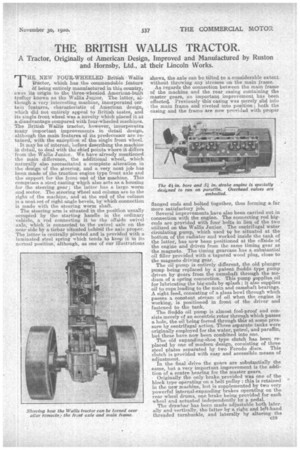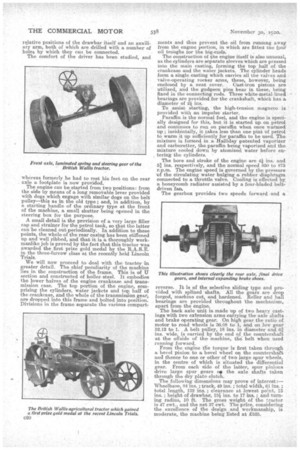THE. BRITISH WALLIS TRACTOR.
Page 13

Page 14

If you've noticed an error in this article please click here to report it so we can fix it.
A Tractor, Originally of American Design, Improved and Manufactured by Ruston • and Hornsby, Ltd., at their Lincoln Works.
THE.. NEW FOUR-WHEELED British Wallis tractor, which has the commendable feature of being entirely manufactured in this country, owes its origin to the three-wheeled American-built traitor known as the Wallis Junior. The latter, although a very interesting machine, incorporated certain features, characteristic of American design, which did not entirely appeal to British tastes, a.nsi its single front wheel. wasa novelty which placed it at &disadvantage compared with four-wheeled machines. The British Wallis tractor, however, incorporates many important improvements in detail design, although the main features of its predecessor are retained, with the exeeption of the single front wheel.
It may be of interest, before describing the machine in detail, to deal with the chief points where it differs from the Wallis Junior. We have already mentioned the main difference, the additional wheel, which naturally also necessitated a complete alteration in the design of the steering, and a very neat job has been made of the traction engine type front axle and the support for the front end of the 'machine. This comprises a steel casting which also acts as a housing for the steering gear ; the latter has a large worm and sector. The steering Wheel and column are to the right of the machine, and at the end of the column is a neat set of right angle bevels, by which connection is made with the steering worm shaft. The steering arm is situated in the position usually occupied by the starting handle in the ordinary vehicle, a rod connecting it to the offside swivel axle, which is connected tothe swivel axle on the near side by a tiebar situated behind the axle proper. The latter is centrally pivoted and is provided with a laminated steel spring which tends to keep it in its normal position; although, as one of our illustrations shows, the axle can be ,tilted to a considerable extent without throwing any stresses on the main frame.
As regards the connection between the main frame of the machine and the rear casing containing the master gears, an important improvement has been effected. Previously this casing was merely slid into the main frame and riveted into position.; both the casing and the frame are now pro.Tislisd with proper
flanged ends and bolted together, thus forming a far more satisfactory jobs Several improvements have also been carried out in connection with the engine. Tho connecting rod bigends are provided with four halts in lieu of the two utilized on the Wallis Junior. The centrifugal water circulating pump, which used tg be situated at the bottom of the radiator and worked inside the tank of the latter, has now been positioned at the offside of the engine and driven from the same timing gear as the magneto. The timing gearcase has a substantial oil filler provided with a tapered wood plug, close to the magneto driving gear. The oil pump is entirely different, the old plunger pump being replaced by a patent Suddo type pump driven by gears from the camshaft through the medium of a spring connection. This pump aupplies oil for lubricating the big-ends by splash; it also supplies oil to cups leading to the main and camshaft bearings.. A sight feed, consisting of a glass bawl through which passes a constant stream of oil when the engine is working, is positioned in front of the driver and fastened to the tank.
The Suddo oil pump is almost fool-proof and consists merely of an eccentric rotor through which passes a hole, the oil being forced through this at some pressure by centrifugal a,ction. Three separate tanks were originally employed for the water, petrel, and paraffin, but these have now been combined into one.
The old expanding-shoe type clutch has been replaced by one of modern design, consisting of three steel plates separated by two Ferodo discs. This clutch is provided with easy and accessible means of adjustment.
In the final drive the gears are substantially the same, but a very important improvement is the addition of a centre bearing for the master gears. Originally the only.brake provided was one of the block type operating on a belt pulley ; this is retained in the new machine, but is supplemented by two very powerful internal-expanding brakes operating on the rear wheel drums, one brake being provided for each wheel and actuated independently by a pedal.
The drawbar has been made adjustable both laterally and vertically, the latter by a right and left-hand threaded turnbuckle, and laterally by altering the 019 relative positions of the drawbar itself and an auxiliary arm, both of which are drilled with a number of holes by which they can be connected. The comfort of the driver has been studied, and whereas formerly he had to rest his feet on the rear axle a footplate is now provided. The engine can be started from two positions: from the side by means of a long remoirable lever provided with dogs which engage with similar dogs on the belt pulley—this as in the old type; and, in addition, by a starting handle of the ordinary type at the front of the machine, a small shutter being opened in the steering box for the purpose.
A small detail is the provision of a very large filler cap and strainer for the petrol tank, so that the latter can be cleaned out periodically. In addition to these points, the whole of the rear casing has been stiffened up and well ribbed, and that it is a thoroughly workmanlike job is proved by the fact that this tractor was awarded the first prize gold medal by the R.A.S.E. in the three-furrow class at the reoently held Lincoln Trials.
We will now proceed to deal with the tractor in greater detail. The chief peculiarity of the machine lies in the construction of the frame. This is of U section and constructed of boiler steel. It embodies the lower 'halves of the engine crankcase and transmission case. The top portion of the engine., comprising the cylinders, water jackets and top half of the crankcase, and the whole of the transmission gear, are dropped into this frame and bolted into position. Divisions in the frame separate the various compost merits and thus prevent the oil from running away from the engine portion, in which are fitted tne tour oil troughs for the big-ends.
The construction of the engine itself is also unusual, as the cylinders are separate sleeves which are pressed into the main casting, forming the top half of the crankcase and the water jackets. The cylinder heads form a single casting which carries all the valves and valve-operating rocker arms, these, however, being enclosed by a neat cover. Cast-iron pistons are utilized, and the gudgeon pins bear in these, being fixed in the connecting rods. Three white-metal-lined bearings are provided for the crankshaft, which has a diameter of 4 ins.
To assist starting, the high-tension magneto is provided with an impulse starter. Paraffin is the normal fuel, and the engine is specially designed for this, but it is started up on petrol and continues to run on paraffin when once warmed up ; incidentally, it takes less than one pint of petrol to warm it up sufficiently for paraffin to be used. The mixture is formed in a Halliday patented vaporizer and carburetter, theparaffin being vaporized and the, mixture cooled down by atomized water before entering the cylinders.
The bore and stroke of the engine are 4i. ins: and 5/ ins, respectively, and the normal speed 850 to 875 r.p.m, The engine speed is governed by the pressure of the circulating water bulging a rubber diaphragm connected to a throttle valve. Cooling is effected by a honeycomb radiator assisted by a four-bladed beltdriven. fan,
The gearbox provides two speeds forward and a
reverse. It is of the selective sliding type and provided with splined shafts. All the gears are drop forged, machine cut, and hardened. Roller and ball bearings are provided throughout the mechanism, apart from the engine. The back axle unit is. made up of two heavy castings with two extension arms carrying the axle shafts and brake operating gear. On high gear the ratio of motor to road wheels is 36.08 to 1, and on low gear 52.12 to 1. A belt pulley, 18 ins, in diameter and 6/ ins, wide, is carried by the end of the countershaft at the offside of the machine, the belt when used running forward. From the engine file torque is first taken through a bevel pinion to a. bevel wheel on the countershaft and thence to one or other of two large spar wheels, in the centre of which is situated the differential gear. From oath side of the latter, spur pinions drive large spur gears cgs the axle shafts taken through the dry plato clutch. The following dimensions may prove of interest:— Wheelbase, 84 ins.; track, 49 ins. ; total width, 61 ins. ; total length, 132 ins. ; clearance at lowest paint, 13 ins. ; height. of drawbar, 134 ins. to 17 ins. ; and turning radius, 10 ft. The gross weight of the tractor is 47 cwt. and the net 37 cwt. The price, considering the excellence of the design and workmanship, is moderate, the machine being listed at £525.




























